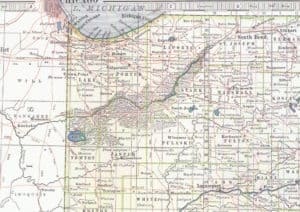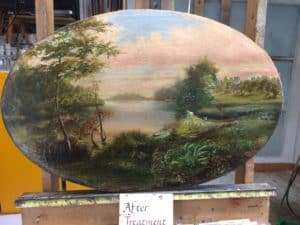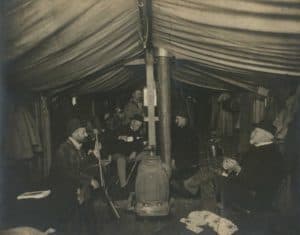The Grand Kankakee Marsh, once known as the Everglades of the North, was a very important place to Lew Wallace.
Everglades of the North

The Grand Kankakee Marsh spread across Indiana, from western St. Joseph County, into Illinois. This “Everglades of the North” covered more than 500,000 acres of land at a depth of 3-4 feet. The river course was 250 miles long, but it curved so much it fit into 90 linear miles.
The first European explorer to visit was La Salle in 1679, but the Potawatomi had been living there for generations. In the 1830s, while Lew’s father David was governor of Indiana, the Potawatomi were forcibly removed to lands further west.
The Swamp Land Act, passed by Congress in 1850, turned the marsh over to the state of Indiana. Throughout the 1860s and 1870s, locals made numerous attempts to drain the marsh.
By the 1880s it had become a hunter’s paradise. The marsh provided a habitat for thousands of species of plants and animals. Mink and muskrat, walleye and waterfowl all made their homes in the marsh. Sportsmen’s clubs were common along the Kankakee. Hunters traveled from around the nation to shoot waterfowl in the marsh, located along the Mississippi Flyway. European nobility considered it an excellent hunting ground.
In 1882, however, Indiana’s chief engineer recommended draining the marsh entirely. Dredge boats created ditches and straightened the channel. Engineers from Indiana cut through a natural limestone dam at Momence, Illinois in 1893. They removed 60,000 cubic yards of limestone. By 1910 most of the water had drained. By 1917, only one percent of the marsh remained.
Lew’s “Happy Hunting Grounds”

Lew Wallace’s first trip to the Kankakee came in 1858 when he went up for duck hunting season with his law partner Samuel Wilson and other young friends from Indianapolis. He spent the rest of his life traveling to the Everglades of the North to rest, relax, and recharge.
He spent much of the summer of 1862 in the marsh after the battle of Shiloh. When orders came for him to assume command of the Middle Department in 1864, Lew was in the Kankakee. He may have been camped at Baum’s Bridge when he learned Ben-Hur would be published.
In June 1888 Lew went fishing on the Kankakee River. Susan wrote to friend Lily Grosvenor that Lew was “in the happy hunting grounds in the northern part of the State with no company but gun, fish pole, dog and a black cook who can also row a boat.”
According to the Starke County Historical Society, Lew spent a great deal of time at Bass Lake. Locals named a tree the Ben-Hur Oak because he sat under it to wrote. His novel The Prince of India was published 1893. Lew wrote in pencil on the first page of the manuscript: “Begun September, 1886, on the Kankakee. Finished, 1892, in the tent under the beeches.”
Fay Folsom Nichols quotes Lew Wallace in her book The Kankakee: “Never in all my world travels have I found a more perfect spot or a more tantalizing river.”
The Thing
Lew owned a houseboat called The Thing, purchased in 1885. The boat served as his home base while on the marsh. He purchased a landing strip near the Pittsburg Gun Club, 41 feet wide and 629 feet long. It would become the mooring and dry dock for his houseboat.
Lew remodeled the boat, beginning with a new deck. Iron pipe flanges on the floor supported a framework of pipes. These pipes held a canvas covering to create the roof and walls. The sides rolled up for ventilation. Lew divided the boat into three rooms: a galley with a bunk for the cook, Lew’s bedroom, and a living room.
He later designed a small rail system to run The Thing up out of the water in the winter.
Social Life in the Everglades of the North

Lew often invited friends to stay on the houseboat with him, or to use it in his absence. A story related by John Binford lends insight into one such occasion. William Parke Herron and Lew Wallace were staying in the marsh. They decided to divide their party and have a fishing contest. General Wallace went up stream while Captain Herron went downstream. When they came back at the end of the day, Lew had a good many fish while Herron had very few.
Sitting around the campfire that evening as they cooked the General’s fish, Herron took a lot of kidding. Next morning as they were starting out, one of the “natives” who served as a local guide sidled up to General Wallace. He said, “General, would you like me to get you some more fish today?” It appears that for Lew, all was fair in love, war, and fishing.
Lew often spent time at Baum’s Bridge, Pittsburg Gun Club, Deep Elbow, and English Lake. If he were feeling social, he would run out the gangplank. If the gangplank was pulled in, however, the General was to be left alone–and all the locals knew it!
After Lew’s death in 1905, Susan sold his land along the Kankakee. The new owners used wood from The Thing to build a cabin.
Conservation and Awareness
In the century since the draining of the Grant Kankakee Marsh, we have discovered the critical role wetlands play. Wetlands filter water, help control flooding, and provide habitat for a large number of migratory birds. Biologists estimate the draining of the marsh destroyed a fifth of the migratory bird population in the U.S. The channelization of the river also created flooding problems.
In 2012, a documentary titled “Everglades of the North” explored the history of the marsh. View the trailer below.
In the 1970s and 1980s, conservationists began working to restore many wetlands. Ironically, at about this same time, the idea of “draining the swamp” came to be known as a positive political change. In actuality, wetlands are important for oxygen production and fish breeding. They serve many other positive purposes as well.
The U.S. Fish & Wildlife Service created the Kankakee National Wildlife Refuge and Conservation Area in 2016 using land donated by Friends of the Kankakee. The refuge is located in Illinois.
3 thoughts on “Everglades of the North”
They are stripping the banks and spraying poison weed killer all over the banks to kill the foliage! Wildlife is dying!!! Please do a follow up!!!